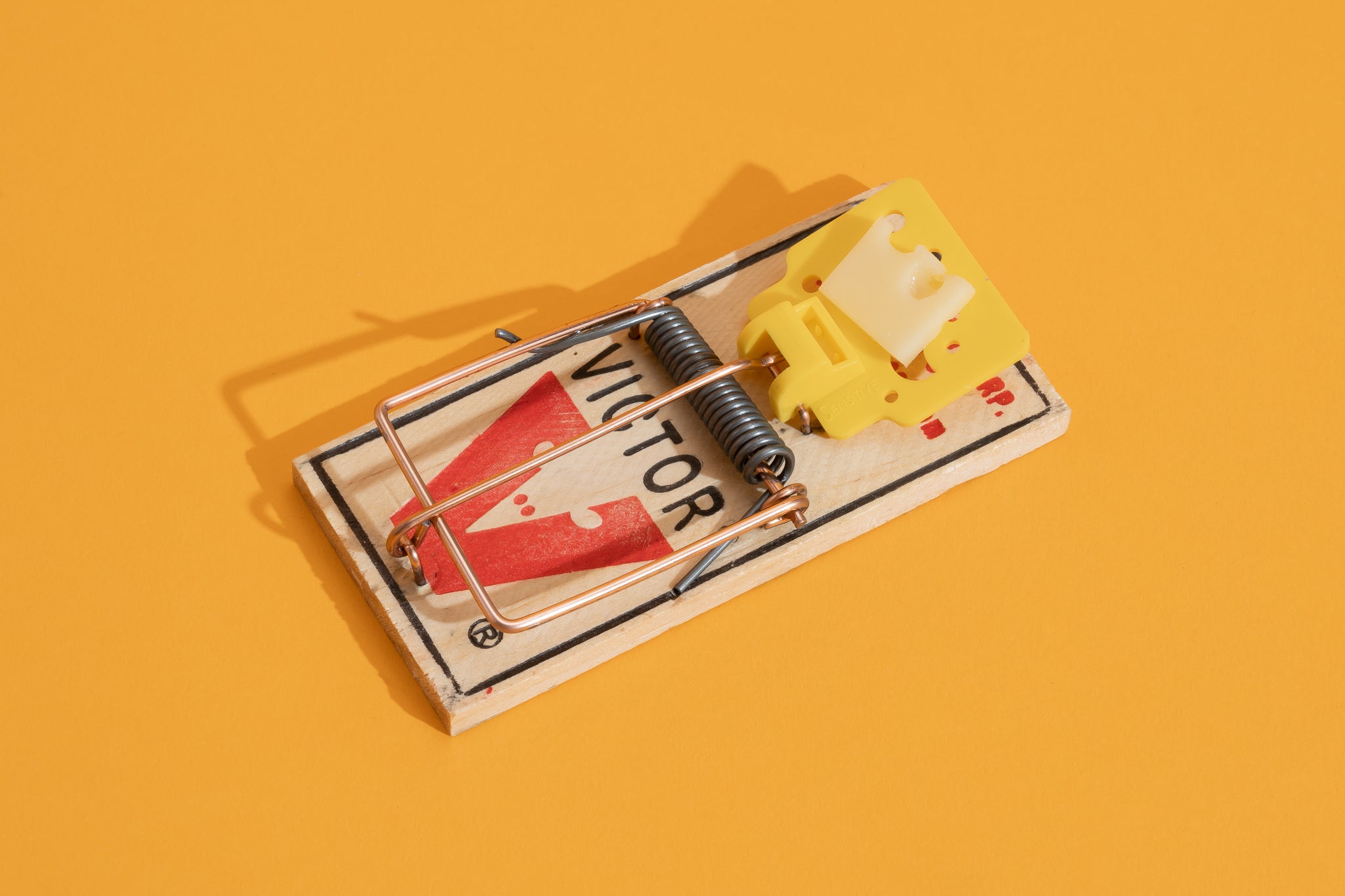Home>Home and Garden>How To Set A Mousetrap


Home and Garden
How To Set A Mousetrap
Published: March 7, 2024
Learn the best techniques for setting a mousetrap in your home and garden. Keep unwanted pests at bay with these simple tips and tricks.
(Many of the links in this article redirect to a specific reviewed product. Your purchase of these products through affiliate links helps to generate commission for Noodls.com, at no extra cost. Learn more)
Table of Contents
Introduction
Setting a mousetrap may seem like a simple task, but it requires a strategic approach to effectively capture those pesky rodents. Whether you're dealing with a minor mouse infestation or simply aiming to prevent one, knowing how to set a mousetrap correctly is essential. This comprehensive guide will walk you through the step-by-step process, ensuring that you are well-equipped to tackle this common household challenge.
Mousetraps have been a staple in pest control for centuries, and they come in various designs, from the classic snap trap to the more modern electronic versions. Regardless of the type of trap you choose, the fundamental principles of setting them remain consistent. By understanding these principles and following the proper techniques, you can increase the likelihood of successfully catching mice while minimizing any potential hazards.
In the following steps, you will learn how to gather the necessary materials, select the most effective bait, and position the trap strategically. Additionally, you will discover the importance of regular trap checks and how to ensure the safety of both humans and pets in the vicinity of the traps. With this knowledge in hand, you'll be well-prepared to tackle your mouse problem with confidence and efficiency.
Now, let's delve into the step-by-step process of setting a mousetrap and take the first step toward reclaiming your home from these unwelcome intruders.
Read more: How To Set Up Pool Balls
Step 1: Gather Your Materials
Before embarking on the task of setting a mousetrap, it's crucial to gather all the necessary materials. Having the right tools and supplies at hand will streamline the process and ensure that you can set the trap effectively. Here's a comprehensive list of materials you'll need:
-
Mousetraps: Select the type of mousetrap that best suits your needs. The traditional snap trap is a popular choice due to its affordability and effectiveness. Alternatively, electronic traps offer a more hands-free approach to catching mice.
-
Bait: Choose an enticing bait that will attract mice to the trap. Common options include peanut butter, chocolate, or small pieces of cheese. Ensure that the bait is fresh and aromatic to maximize its appeal to rodents.
-
Gloves: Wearing gloves is essential to prevent leaving human scent on the trap and bait, which could deter mice from approaching the trap.
-
Cleaning Supplies: It's important to have cleaning supplies such as disinfectant, paper towels, and gloves on hand for handling the trap and any potential messes that may occur during the process.
-
Safety Equipment: If you're using traditional snap traps, consider having safety equipment such as goggles and gloves to protect yourself from accidental injury while setting the traps.
-
Location Plan: Before setting the traps, have a clear plan of where you intend to place them. Identify areas where mouse activity is most prevalent, such as along walls, near food sources, or in secluded spaces.
By ensuring that you have all these materials readily available, you can streamline the process of setting the mousetraps and increase the likelihood of successfully capturing any mice that may be lurking in your home. With the materials gathered, you're now ready to move on to the next step of setting the bait for the traps.
Remember, preparation is key to effectively addressing a mouse infestation, and having the right materials at hand will set the stage for a successful trapping endeavor.
Step 2: Set the Bait
Setting the bait for your mousetrap is a critical step in ensuring its effectiveness. The bait serves as the enticing lure that attracts mice to the trap, increasing the likelihood of a successful capture. When selecting bait, it's important to choose options that are highly appealing to mice and can easily be secured to the trap. One of the most popular and effective choices for mousetrap bait is peanut butter. Its strong aroma and sticky texture make it an irresistible temptation for mice. Alternatively, small pieces of chocolate or cheese can also serve as effective bait options.
To set the bait, use a small amount of the chosen lure and place it on the designated bait area of the trap. For snap traps, this is typically a small indentation or bait pedal located at the center of the trap. When using electronic traps, the bait can be positioned in the designated compartment or bait cup. It's important to use a minimal amount of bait to ensure that the mice must make direct contact with the trap's trigger mechanism, increasing the likelihood of a successful capture.
When handling the bait, it's advisable to wear gloves to minimize the transfer of human scent, which could potentially deter mice from approaching the trap. Additionally, gloves help maintain a hygienic environment and prevent the spread of any potential contaminants. By taking these precautions, you can maximize the effectiveness of the bait and increase the chances of luring mice to the trap.
In addition to selecting the right bait and positioning it correctly, it's essential to ensure that the bait remains fresh. Regularly check the traps to confirm that the bait has not spoiled or dried out, as fresh bait is more likely to attract mice. By maintaining fresh and appealing bait, you can optimize the trapping process and improve the overall effectiveness of your mousetrap setup.
With the bait successfully set, you have laid the foundation for an enticing and effective mousetrap. The next step involves positioning the trap strategically to maximize its potential for capturing mice.
Step 3: Set the Trap
Setting the trap is a crucial step in the process of effectively capturing mice. Whether you are using traditional snap traps or modern electronic versions, the proper setup is essential to maximize the trap's potential. Here's a detailed guide on how to set the trap for optimal results.
Traditional Snap Traps
If you are using traditional snap traps, start by carefully pulling back the kill bar and holding it in place. This step is crucial for preventing accidental activation while setting the trap. Next, engage the trap's setting mechanism, which may involve pressing down on a lever or securing a latch. Ensure that the trap is set with enough tension to swiftly close when triggered but not too sensitive that it could be easily activated by slight movements.
Once the trap is set, position it in areas where mouse activity has been observed. Common hotspots include along walls, near food sources, and in secluded spaces. Place the trap perpendicular to the wall with the baited end facing the wall, as mice tend to travel along edges. This positioning increases the likelihood of mice encountering the trap as they navigate their regular paths.
Read more: How To Set Up Face ID On IPhone
Electronic Traps
For electronic traps, the setup process may vary depending on the specific model. In general, start by opening the trap's bait compartment and placing the bait inside. Follow the manufacturer's instructions to activate the trap and ensure that it is ready for use. Some electronic traps may require the press of a button or the insertion of batteries to power the device.
Similar to traditional snap traps, strategically position electronic traps in areas of high mouse activity. Ensure that the trap is placed on a stable surface and that the entrance is easily accessible to mice. Electronic traps often feature entrance tunnels or openings designed to guide mice into the capture area, so position the trap to take advantage of these features.
Safety Considerations
Regardless of the type of trap you are using, it's essential to prioritize safety during the setup process. Exercise caution to avoid accidental injury, especially when handling traditional snap traps with powerful spring mechanisms. If using safety equipment such as gloves and goggles, ensure that they are worn throughout the setup process to minimize any potential risks.
By following these detailed steps and safety considerations, you can effectively set the trap to increase the likelihood of capturing mice while minimizing potential hazards. With the trap successfully positioned and ready for action, the next step involves placing the trap in strategic locations and regularly monitoring its activity.
Step 4: Place the Trap
Strategic placement of the mousetrap is a pivotal factor in its effectiveness. Once the trap is set and ready for action, careful consideration should be given to where it will be positioned. Identifying areas of high mouse activity and understanding the behavior of these rodents are key elements in determining the optimal placement of traps.
When placing traditional snap traps, it's essential to position them perpendicular to the wall, with the baited end facing the wall. Mice tend to travel along edges, and by placing the trap in this manner, you increase the likelihood of intercepting their path. Additionally, consider placing traps near potential entry points, such as gaps in walls or around pipes, as mice often use these routes to access interior spaces.
For electronic traps, strategic placement is equally important. These traps are designed to guide mice into the capture area through entrance tunnels or openings. Position the trap in areas where mouse activity has been observed, ensuring that the entrance is easily accessible to mice. Placing the trap on a stable surface and in proximity to potential hiding spots can also increase its effectiveness.
It's important to note that traps should be positioned out of reach of children and pets to prevent accidental activation or injury. Additionally, consider placing traps in discreet locations to maintain a tidy and inconspicuous environment. While mice are attracted to secluded spaces, it's important to strike a balance between strategic placement and the safety of household members and pets.
Regularly monitor the placement of traps and adjust their positions as needed based on observed mouse activity. If traps remain untouched after a period of time, consider relocating them to new areas where mouse activity is prevalent. By adapting the placement of traps to align with changing patterns of mouse behavior, you can increase the likelihood of successful captures.
By thoughtfully considering the placement of traps and adapting their positions based on observed activity, you can optimize their effectiveness in capturing mice. With the traps strategically positioned, the final step involves regular monitoring and maintenance to ensure that they remain active and ready to address any mouse activity in your home.
Step 5: Check the Trap Regularly
Regular monitoring of mousetraps is essential to gauge their effectiveness and address any captured mice promptly. Checking the traps regularly not only increases the likelihood of successful captures but also ensures that any trapped mice are dealt with in a timely and humane manner.
When monitoring traditional snap traps, it's important to approach them cautiously to avoid accidental activation. Carefully lift the traps and inspect them for any signs of captured mice. If a mouse has been caught, it's crucial to handle the trap with care to prevent injury to yourself and the captured rodent. Utilizing gloves and following safe disposal practices is paramount to maintaining a hygienic environment and minimizing potential health risks.
For electronic traps, checking them regularly involves inspecting the trap's indicator light or digital display to determine if a mouse has been captured. Some electronic traps feature alert systems that notify users when a mouse has been trapped, streamlining the monitoring process. Upon confirming a capture, follow the manufacturer's instructions for safely disposing of the mouse and resetting the trap for continued use.
In addition to checking for captured mice, it's important to assess the condition of the bait and refresh it as needed. Fresh bait is more likely to attract mice, so ensuring that it remains aromatic and appealing is crucial for trap effectiveness. Regularly replacing the bait also minimizes the risk of it spoiling and becoming unappealing to rodents.
Monitoring the traps also provides valuable insights into the extent of mouse activity in your home. By observing which traps have been triggered and the frequency of captures, you can gain a better understanding of the areas where mice are most active. This information can guide you in adjusting the placement of traps to target high-traffic areas and increase the likelihood of successful captures.
By checking the traps regularly, you can maintain an effective trapping strategy and address any mouse activity promptly. This proactive approach not only increases the likelihood of capturing mice but also contributes to creating a hygienic and pest-free environment in your home. Regular monitoring is a key component of successful mousetrap usage, ensuring that you stay one step ahead in effectively addressing any mouse infestation.
Read more: How To Set Up A Graco Pack And Play
Conclusion
In conclusion, mastering the art of setting a mousetrap is a valuable skill that empowers homeowners to address mouse infestations effectively and proactively. By following the step-by-step process outlined in this guide, individuals can navigate the intricacies of trap setup, baiting, and strategic placement with confidence. The culmination of these efforts yields a comprehensive approach to pest control that prioritizes both effectiveness and safety.
Successfully setting a mousetrap begins with the meticulous gathering of materials, ensuring that all necessary tools and supplies are readily available. This preparatory step sets the stage for a streamlined and efficient trapping process, minimizing the need for interruptions or delays.
The selection and positioning of bait play a pivotal role in luring mice to the trap, maximizing the likelihood of successful captures. By choosing aromatic and appealing bait options and positioning them strategically within the trap, individuals can create an enticing lure that entices mice to approach and trigger the trap.
The meticulous setting of the trap itself, whether traditional snap traps or modern electronic versions, requires attention to detail and a focus on safety. By following the recommended techniques for setting each type of trap, individuals can minimize the risk of accidental activation and ensure that the traps are primed for effective use.
Strategic placement of the traps in areas of high mouse activity is a key element in the trapping process. By leveraging insights into mouse behavior and movement patterns, individuals can position traps to intercept the rodents' paths, increasing the likelihood of successful captures while maintaining a safe environment for household members and pets.
Regular monitoring and maintenance of the traps complete the trapping process, allowing individuals to assess their effectiveness, address captured mice promptly, and adapt the placement of traps based on observed activity. This proactive approach ensures that the trapping strategy remains optimized and responsive to changing patterns of mouse behavior.
In essence, mastering the art of setting a mousetrap involves a combination of preparation, strategic decision-making, and proactive monitoring. By embracing these principles, individuals can reclaim their homes from unwanted rodent intruders, fostering a hygienic and pest-free environment for themselves and their families. With the knowledge and skills acquired from this guide, individuals are well-equipped to tackle mouse infestations with confidence and efficiency, ensuring a harmonious and pest-free living space.













